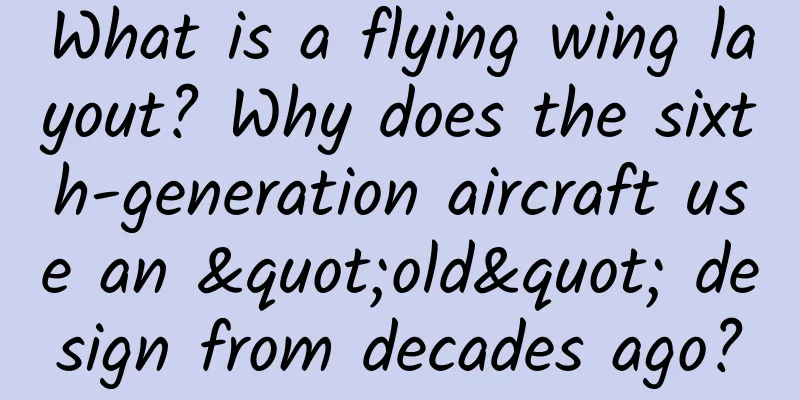What is a flying wing layout? Why does the sixth-generation aircraft use an "old" design from decades ago?

|
The flying wing layout, as the name implies, is a "full wing". It eliminates the structure of the fuselage and tail wing, allowing the wing to directly assume all the functions of the aircraft, and also integrates all the equipment, fuel and weapons. Although it looks like a design from a science fiction work, the flying wing layout actually has a long history. As early as World War II, the Holden brothers in Germany began to try this design, believing that it could bring revolutionary flight performance. At that time, Germany was in urgent need of such a breakthrough. Thus, the Horten Ho 229 was born. This is the world's first fighter plane with a flying wing design. Its wing area is huge, about 51.8 square meters, which can greatly increase lift, reduce drag, and increase speed and maneuverability. Especially when flying at high speeds, the advantages of the flying wing design are particularly obvious, which can reduce the aerodynamic drag caused by the traditional fuselage and tail. However, it was still late, and Germany's fate did not change because of it. The end of World War II meant the termination of the development of the Horten Ho 229. Although the advantages of the flying wing design were obvious, many complex control systems were not effectively solved at the time, and its potential was not fully tested, leaving only a revolutionary design idea. The Americans took the idea and tried the flying wing layout during the Cold War, and the famous Northrop YB-49 bomber was unveiled. This aircraft had an amazing range and bomb load, but because it had no tail, flight control became very difficult, and the electronic control technology at the time was not mature, so it was ultimately not put into actual combat. The advantages and disadvantages of the flying wing layout are almost equally prominent. Let’s talk about the biggest advantage first – reducing aerodynamic drag. The flying wing combines the wing and the fuselage into one, making the air flow smoother during flight, reducing vortices and wake, and thus improving flight efficiency. At the same time, the flying wing design can provide greater lift and reduce the drag caused by the tail. During high-speed flight and high maneuvers, the flying wing layout is particularly stable, and the flight performance is significantly improved. Finally, the flying wing design naturally reduces the radar reflection surface. Its streamlined fuselage and fewer sharp angles reflect less radar waves. Especially in modern stealth design, the flying wing layout has become a good foundation for stealth technology. The disadvantage is that it is difficult to control the flight. Since there is no tail, flight control becomes a big problem. The early Horton Ho 229 tried to make up for it with complex control surfaces, but without a fly-by-wire system, the pilot could hardly control it. It was not until the B-2 "Ghost" adopted a modern flight control system that the flying wing layout really began to be put into actual combat. With the advancement of technology, especially breakthroughs in flight control technology, material science and stealth technology, the flying wing layout has gradually become the first choice for the new generation of fighter jets, which is why the sixth-generation aircraft looks like a leaf. The streamlined shape and tailless design of the flying wing greatly reduce the aircraft's radar reflection area, or RCS. For example, the RCS of the B-2 bomber is only equivalent to that of a pigeon, and the sixth-generation aircraft has further reduced this value, especially in the top and side view angles. The flying wing layout also helps the sixth-generation aircraft improve its supersonic cruise capability, reduce air resistance, have a higher lift-to-drag ratio, and significantly improve fuel efficiency and range. The flying wing layout not only has advantages in aerodynamic shape, it can also make the internal design of the aircraft more compact, increase the flexibility of the aircraft, and is suitable for multi-mission fighters. Coupled with thrust vectoring technology and artificial intelligence-assisted flight control, the shortcomings of the flying wing layout have almost disappeared, leaving only its many advantages. This article is a work supported by the Science Popularization China Creation Cultivation Program. Author: Rocket Uncle Science Popularization Author Reviewer: Zhang Zhang, researcher at Beijing Institute of Space Mechatronics Produced by: China Association for Science and Technology Department of Science Popularization Producer: China Science and Technology Press Co., Ltd., Beijing Zhongke Xinghe Culture Media Co., Ltd. |
<<: These things you use every day were originally designed for people with disabilities
>>: The reason why the "face plate" has become bigger has been found! (It's not because of obesity)
Recommend
How to write a popular short video title!
In life, many people want to learn, so they study...
Toutiao | Only open to small and medium-sized advertisers, how good is the conversion rate of the CPA model?
The conversion cost is sometimes high and sometim...
Domestically produced drama plays the Korean wave card. What is there to look forward to in "High Quality Unrequited Love"?
"4K technology, super IP, star lineup, huge ...
If you only have 5 seconds, can your copy capture the user?
The world is so busy, no one will waste one more ...
The mortality rate is over 90%! To prevent sudden cardiac death, pay attention to these 6 signs!
When the "lifeline" on the Holter monit...
Taking Maoyan Movie as an example, the UCG platform operation strategy is explained in detail
Logically speaking, we should first prove that Ma...
Danzhou SEO training: How to promote mobile websites? How to optimize mobile SEO?
In many cases, after people optimize their websit...
Information flow advertising: four creative ideas and five directions, a quick introduction to game promotion
As a novice in game promotion , how can I get sta...
Operational promotion: 4 general methods and techniques to increase followers!
Today, we will share 4 general tips for increasin...
Using USB flash drives and memory cards to store the "soul"? Is it possible for people to achieve "conscious immortality"?
We all know that the brain is the organ that prod...
It was not Sina but WeChat that killed Tencent Weibo
Tencent Weibo has finally met its day of death. O...
Is soy sauce full of “technology and hard work”? Is “zero additives” really better?
Recently, the food safety field has been in turmo...
Short video live streaming has entered the second half. Is there still a bonus period for joining now?
In 2020, live streaming of goods via short videos...
Giant Panda: Mine, mine, all mine!
"He He", "Jiu Jiu" and "...
Google Play Services will stop supporting the "Jelly Bean" platform
Google Play officially announced that future vers...






![[Case] How does an e-commerce app develop an operation and promotion strategy from scratch?](/upload/images/67cc4e8168971.webp)


